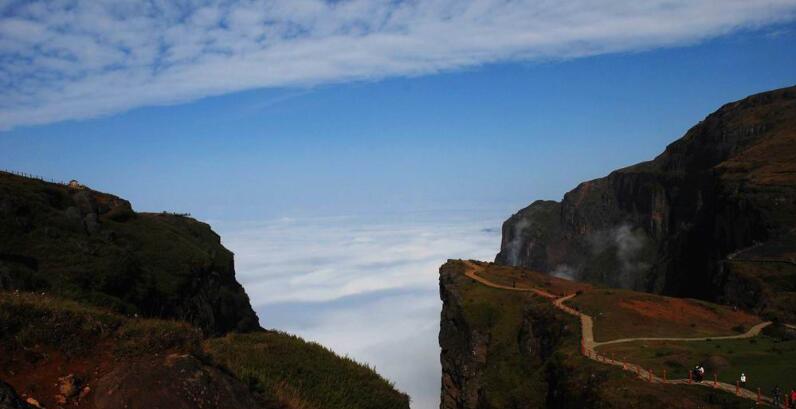Overlooking Danshanbao National Nature Reserve in Yunnan Province is like seeing a painter splashing vibrant hues of golden yellow and glaring red. These two stunning colors occupy the vast area of villages and fields. Only a vigorous green competes with these colors, making a tapestry for the senses. The air amongst the mountains and plains is fresh, and the sky above is dear and beautiful. White clouds pile upon one another, mesmerizing the viewer. Flocks of black-necked cranes fly above, completing a splendid picture.
I chose to visit Dashanbao again to see its irresistible beauty. When I got off the train in Zhao-tong County, Yunnan, it was almost 4 o’clock in the afternoon. It took me more than 3 hours to drive 86 kilometers up to the mountains. The snow spread like a white blanket over the mountains, making every tree and bush glittering and translucent. Suddenly, the singing of a flock of black-necked cranes interrupted my thoughts. Chirping away, they swept past me, leaving me wondering if I was in a fairy tale.
Sleeping at night in a black-necked crane conservation station is a heavenly experience. At night, as you fall asleep more than 500 black-necked cranes accompanying you in the front and to the left of the Dahaizi shelter. They stay throughout the night but just prior to sunrise, the whole flock awakens in songs and cries.
The life of the staff in a conservation station is bittersweet. Every night they must check the shelter for the black-necked cranes, and work hard to defuse any danger from either humans or animals that seek to bother the cranes. They go to sleep later than the cranes, but must awake at the same time as these majestic birds. They check the numbers of the flock with a high-powered telescope, following them as they soar along the horizon in the rosy dawn, and gently land in the tranquil fields.
Zhang Yong, a staff member from local forestry police station located in the conservation station, told us in detail that the black-necked cranes we had originally seen were the “hostesses” of Dashanbao. This crane family is always the first to be seen by anyone arriving to the nature reserve. At die entrant of another mountaintop, Zhu Yong pointed out to us a family of four black-necked cranes, stating that they were the guardians of this area. These cranes take charge of die safety of the flock in Dashanbao. Once a man-made or predator threat is detected, they use a special call, to send out a guard signal He pointed to another group of cranes and explained that they were the guards for the shelter. In the early dawn, black-necked cranes leave this shelter and start to forage far away after a night of rest. Yet the shelter is their home and must be guarded. So according to the hierarchy amongst this crane flock those cranes left at the shelter are on guard duty. Other different roles are “petrol” cranes, “actor” cranes, and much more. Zhu Yong excitedly introduced us to the detailed professions and responsibilities of every crane group. Before we knew it, Jigong Mountain was already in front of us. We saw a huge jade-like ice surface lying on Tiaodun River reservoir, like a shinning pearl on the plateau.
“Walk along this mountain ridge and you can see the full view of Dashanbao. I bet you will pray for living five hundred years longer when you are standing there and enjoying the natural beauty of it”, said Zhu.
On my way home, I contemplated the amazing place that was Dashanbao. Basalts and Mesozoic sandstones pile up, buttressing it with endless rising peaks and adjoining ravines. Beneath the ranges and peaks there are 3,150 hectares of marshes and swamps, such as Dahaizi, Lelizhai, Qinjiahaizi, Luojiapingzi, Zhonghaizi, Dahebian, Longjiadadi, Xianrentian, and much more. Moreover, God provides this wonderful place with a total of 162 species, 16 orders and 36 families. Black-necked crane, hooted crane, white-tailed eagle, golden eagle and many other kinds of birds, can be found easily here. More than 1,300 black-necked cranes, which bird lovers are crazy for, spend their winters here.
As we were leaving Dashanbao, the “hostess” cranes tweeted to us, extending their long necks to wish us bon voyage. An old man was clearing away the plastic garbage in the fields. We stopped our car to ask him what he was doing. He explained that nowadays plastic mulching is widely used in farm work. It is so destructive that if swallowed by black-necked cranes, it will undoubtedly threaten their health, and even their life.
After hearing that, I agreed with and admired this old man’s concept of nature. I realized that the beauty and loveliness of the black-necked crane inspire people to love and cherish, and teaches them how to scientifically use Dashanbao’s precious natural resources. As well the intelligent and industrious nature reserve staff and passionate locals will sustain the beauty of Dashanbao and make it last forever.









